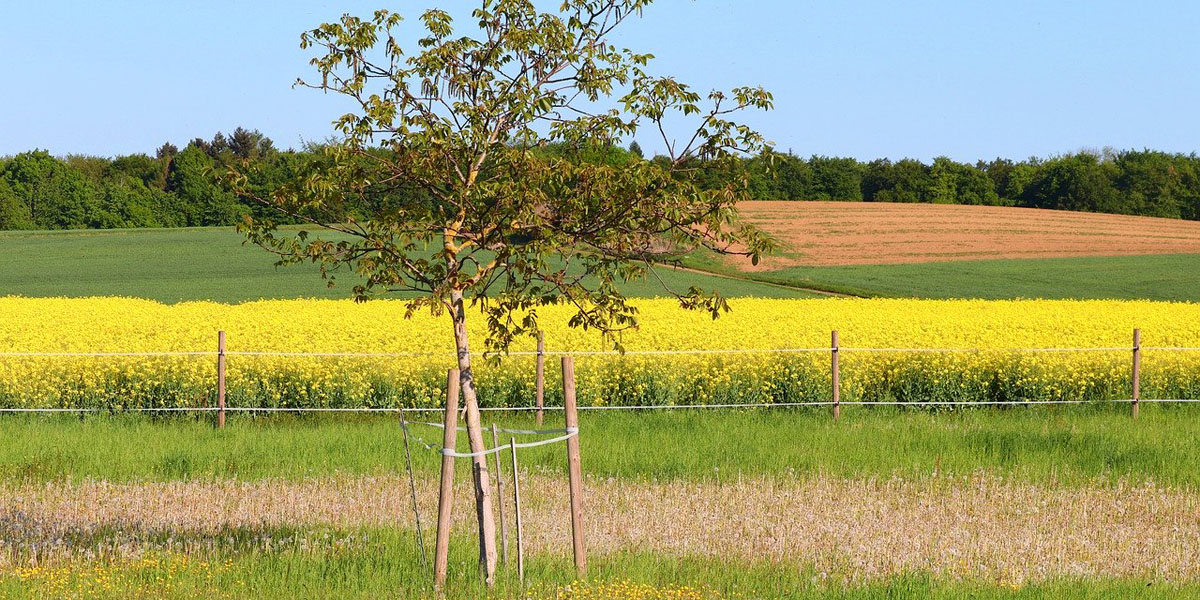Your trees are an investment, so you’ll want to make sure they’re treated properly from the moment you plant them. Often, this starts with staking your trees when they’re first planted. Read on to learn about whether, how, and why your new trees should be staked and when those stakes should be removed. (Hint: it may be sooner than you think.)
Why Young Trees May Need to be Staked
Generally, newly-planted trees are small. The cost and effort of installing a large, mature tree is often too high for homeowners to afford. Plus, smaller, younger trees have much better odds of surviving the stress of transplanting than do large trees.
Whether your new tree comes in a nursery container or is balled and burlapped, you might need to have it staked as part of your young tree’s ongoing care.
This is because a tree’s root system is also its anchoring system, keeping the tree stable and upright in soil. When a young tree is planted, its root ball is the extent of its root system – and that can be pretty small! Because it takes time for a newly-planted tree to settle in and grow roots out into the surrounding soil, we sometimes use staking to keep trees stable until they can stabilize themselves.
NOTE: Tree staking is not the same as the single nursery stake young trees in nursery containers may come with. If you get a tree with a nursery stake, remove it when you plant the tree. Nurseries stake young trees to promote their vertical growth while containers are close together to save growing space; these trees are often floppy and unable to stay upright on their own. Additionally, the nursery stake is driven into a tree’s sensitive rootball and you won’t want to leave it there.
How Tree Staking Helps New Trees
The most important thing staking does for your new tree is stabilize it in its planting hole. The new feeder roots your tree sends out after it’s been planted are delicate and fragile, and the backfilled soil in your planting hole should not be heavily compacted. To ensure that these roots grow and expand into the neighboring soil, you’ll want to limit how much your new tree (and its roots) can move in the wind.
The flexible ties that attach a tree’s trunk to stakes should always be loose enough to allow the trunk to move in the wind. At the same time, these ties should also stop excessive trunk swaying that moves a tree’s rootball and tears or severs newly formed roots.
What to Use for Tree Stakes
The best tree stakes are wood or metal and are either made from individual components or sold as a kit. Whatever material you use for stakes, make sure they’re rigid, strong, properly sized for your new tree (often, that’s larger than you may think), and driven securely into the ground. Then attach the tree to the stakes with soft, loose, flexible ties.
 Staking vs Guying
Staking vs Guying
Another staking method is called “guying.” Guying uses flexible cables attached at or below ground level and connected to a tree’s trunk at the lowest feasible point that stabilizes the tree. The cable’s attachment points are always soft, flexible, and cushioned to prevent damage to a tree’s trunk, branches, or bark. This is a more advanced staking method that should be left to professionals – it’s easy to snap a tree’s trunk when done incorrectly.
Always Tie a Tree to Stakes the Right Way
Attach flexible ties to the stakes and loop them loosely around the tree’s trunk at the lowest practical height. Find the lowest point on the tree’s trunk that will allow natural movement without trunk breakage, and without wind-blown branches damaging or being damaged by any nearby surfaces.
Never use rigid or abrasive ties, nor tie a tree so that it is immobilized.
- Avoid wire, zip ties, or anything bound tightly to a tree’s trunk.
- Avoid flexible ties that have a rigid cable or wire in their center, as the covering material will wear away and the wire will dig into a tree’s bark. Rigid ties will saw against a tree’s bark as the tree moves in the wind and can cause trunk girdling, permanent damage or tree death.
- Never keep a tree tied so firmly that natural movement of the trunk is prevented. This natural swaying and moving in wind stimulates trunk taper and internal trunk strength.
Staking Is Not Always Necessary
Many newly-planted trees do not need to be staked, but you may want a tree-care professional to assess the situation and decide. Tree staking has less to do with the type of tree and more to do with its size, form, and the existing conditions where the tree is being transplanted.
Generally, if a tree’s trunk bends or is thin and too flexible, it will need staking while its rootball and lateral branches develop.
Arborists and tree care professionals prefer to let a tree’s natural development proceed with limited interference, and therefore tend to use minimal staking. But professionals also understand that because a newly planted tree may not be able to support itself, stakes can be invaluable for a tree’s establishment, particularly if the tree is planted in a windy location.
How Long to Leave Stakes in Place
Many people go by the general rule of thumb that you should leave stakes in place for between six months to two years. But, instead of relying on a general rule, have your tree regularly examined by an arborist so its stakes can be removed as soon as the tree is stable. This may be less than six months, or it could be longer than two years, depending on the tree’s development and its surroundings.
Like all plants, trees grow toward the sun, which keeps them vertical and promotes an even crown of branches. Excessive wind, however, can deform a young tree in the direction the wind blows and cause it to develop an uneven root system. These two things can make a tree unstable and prone to falling over, so examine your tree carefully before removing stakes and ties.
If you free your tree’s trunk from its ties and the tree’s trunk stays upright in windy conditions, chances are you can remove its stakes. But you’ll want to examine its rootball as well, to make sure there’s no evidence of a loose rootball shifting or root tearing. A stable, sound root system is one of the main requirements for tree health and longevity.
Problems Caused by Leaving Stakes in Place Too Long
Stakes that are left on too long can often damage a tree. Over time, flexible ties are pulled taut and both constrict the tree’s movement and begin to girdle the trunk. Sometimes, stakes fall over and pull the tree’s trunk along with them. The tree doesn’t have to fall all the way over to become damaged; roots that stay in tension from the constant pull of the stakes will be damaged or die.
What’s at Stake
Trees are lifetime investments, so start yours off right! Tree stakes are not meant to be permanent, so be sure to install stakes correctly and remove them as soon as it’s safe to do so. Have your trees and their stakes evaluated by an experienced tree care professional to be sure it’s time to cut your tree loose.
If you’re interested in having a tree planted or transplanted, or if you want to be sure your new tree is thriving and it’s safe to remove its staking system, give us a call. We’re experienced professionals who love trees, and we’re here to help keep your trees vigorous and healthy right from the start.





 Staking vs Guying
Staking vs Guying
